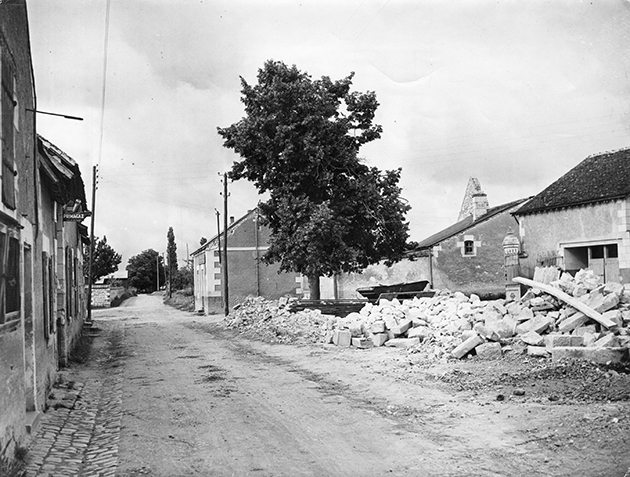Remembering the ‘martyr’ villages: Maillé

Known by some as “the other Oradour-sur-Glane”, this village in Indre-et-Loire had an entirely different fate from its Limousin counterpart, as a memorial landscape. Following the Maillé massacre, even before the war was over, it was decided that the village should be completely rebuilt, a choice not without consequences for the preservation of its memory.
On 25 August 1944, while Paris was celebrating the return of freedom, Maillé, a small village in the Touraine area, was practically wiped off the map.
During the morning, a group of 80 German soldiers invaded the village. Over more than three hours, they forced their way into houses and murdered their inhabitants, leaving a trail of burning buildings in their wake. Men, women, children, babies: no one was spared. In the afternoon, an artillery piece, positioned on a neighbouring hill that same morning, began shelling the village to complete the destruction. By evening, the death toll was horrific: 124 victims, 48 of them children, and 52 out of 60 homes burnt down.

Maillé’s main street, 1945. © Private collection – Maison du Souvenir
As early as September 1944, the question of the reconstruction of the village was raised. Town planner W. Roger Coulant was commissioned to draw up the plans for Maillé’s reconstruction. He decided to make the reconstructed village a “model village” so that, “over the years to come, this dark episode is gradually erased from the memory of the inhabitants of the grateful ‘martyr’ village.” In August 1945, building work began, and the foundation stone was laid by the Minister for Reconstruction, Raoul Dautry. By 1953, most of the houses were habitable, and by 1960, the reconstruction was officially completed. This relative speed was due in particular to the action of the local council, which regularly asked for the plans to be simplified.
In the meantime, the horror of Maillé was forgotten. Even in Touraine, few were aware of the distinctive nature of the massacre, despite it being second only to Oradour-sur-Glane in terms of the number of victims massacred by the Germans on French soil. Because the commemorations fall during parliamentary recess, as well as coinciding with the anniversary of the Liberation of Paris, it was not until 2004 that, since Raoul Dautry, a government minister attended the anniversary ceremony in the ‘martyr’ village. Aside from a handful of discreet steles, there is nothing in the village to recall the massacre and the survivors never mention that terrible day, even amongst themselves.
In 1994, an exhibition devoted to the massacre, organised by the departmental archives, loosened people’s tongues. A survivors’ association was set up and plans were put forward for an interpretation centre. In the early 2000s, work got underway on converting a former café to house the centre, and the first interviews were filmed. One of these films was to have unexpected consequences for the village. Already alerted by an article in the German press, a public prosecutor from Dortmund, specialised in war crimes investigations, found out that one of the films about the Maillé massacre was to be shown in Stuttgart.
In it, he identified many flaws in the inquiry into the Maillé massacre carried out in France in the postwar years, and decided to open a new inquiry. In July 2008, the prosecutor’s visit prompted a first wave of media interest. He was followed one month later by Nicolas Sarkozy, who became the first French president to honour the annual commemoration of the massacre with his presence. In November, it was Prince Albert of Monaco’s turn to visit the ‘martyr’ village, to pay tribute to the Hales, American patrons of Maillé and friends of the Grimaldi family, who died in 1958. These three official visits to Maillé marked a turning point in the history of the village, which suddenly emerged from oblivion.
Even so, today Maillé is still struggling to make a place for itself in the national memory. The absence of visible traces of the massacre, unlike the ruins of Oradour-sur-Glane, make it hard to imagine the scale of the episode. It is also possible to walk through the village without having any idea of the tragedy that took place there.
Maison du Souvenir, Maillé. © Maison du Souvenir
Only the distinctive architecture of the reconstruction gives visitors an inkling that the commune was badly damaged during the Second World War. Since the opening of the Maison du Souvenir interpretation centre, the choice has been made to isolate the memory of the massacre within its four walls. It would be too much to ask residents to confront in their daily lives the horrors that took place in their homes, gardens and streets.
A ‘martyr’ village because of its tragic history, Maillé is first and foremost a village facing all the difficulties that rural communities face, such as shop closures. For most residents who have moved here within the last two decades, preserving that memory is of secondary concern. For the local council and remembrance organisations, the work on the Maillé massacre has therefore been a product of trade-offs and compromise between the need to remember and the need to preserve normal life in this little village.

